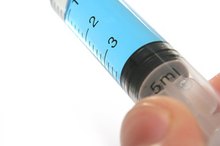What is a Standard Glucose Solution?
A standard solution of glucose contains a known quantity of glucose in a known quantity of water. Scientists use standard glucose solutions to measure the concentration of a glucose in an unknown solution. These tests are helpful in many research experiments but also find practical medical application when testing patients for diabetes.
Glucose
Glucose is a 6-carbon sugar molecule, the most common carbohydrate in your body. People often refer to glucose as "blood sugar" as it circulates throughout your blood at a concentration of about 65 to 110 mg/mL. Classified as a monosaccharide, an aldose, a hexose and a reducing sugar, glucose chemically reduces other compounds in oxidation/reduction reactions by readily donating electrons. Glucose is also known as dextrose or D-glucose, due to its dextrorotatory property, the ability of glucose solutions to rotate plane polarized light to the right.
- Glucose is a 6-carbon sugar molecule, the most common carbohydrate in your body.
- People often refer to glucose as "blood sugar" as it circulates throughout your blood at a concentration of about 65 to 110 mg/mL.
- Classified as a monosaccharide, an aldose, a hexose and a reducing sugar, glucose chemically reduces other compounds in oxidation/reduction reactions by readily donating electrons.
Standard Solutions
The Effect of Benedict Solution on Glucose
Learn More
Standard solutions in general contain a known amount of substance dissolved in a known quantity of another substance. Usually, a standard glucose solution refers to a 1-percent glucose solution. Preparing a 1-percent standard glucose solution involves dissolving 1 g of glucose in 100 ml of water. Glucose standard solutions are used to create calibration curves against which unknown solutions are measured. These curves then help determine the concentration of the unknown solution.
- Standard solutions in general contain a known amount of substance dissolved in a known quantity of another substance.
- Usually, a standard glucose solution refers to a 1-percent glucose solution.
Calibration Curves
Reactions of glucose with potassium permanganate generate calibration curves. Glucose readily donates electrons to permanganate ions in an oxidation-reduction reaction. The rate of this oxidation-reduction reaction depends on the concentration of glucose in solution. Solutions of permanganate ions have a distinct pinkish-purple color. When this solution is reduced, it becomes colorless. By measuring the different rates at which different known concentrations of glucose turn the pink solution colorless, you can generate a chart or "calibration curve" of concentration of glucose versus time.
- Reactions of glucose with potassium permanganate generate calibration curves.
- By measuring the different rates at which different known concentrations of glucose turn the pink solution colorless, you can generate a chart or "calibration curve" of concentration of glucose versus time.
Using Calibration Curves
Real Life Uses of Titration
Learn More
After generating a calibration curve using a standard glucose solution and potassium permanganate, you can then determine the concentration of glucose in an unknown solution. Add the same volume of the unknown glucose-containing solution that you added of the known glucose containing solution, to the pink potassium permanganate solution. For example, if you used 2 mL of your 1 percent glucose solution when making your glucose calibration curve, use 2 mL of your unknown glucose-containing solution. Measure the rate at which the unknown solution turns the pink permanganate solution clear. Compare that rate to the rate of the known glucose solutions and you can determine the concentration of the glucose in your unknown solution. For example, if your unknown solution took the same amount of time to turn the pink solution clear as the 1-percent solution, then your unknown solution contains 1 percent glucose. If it took half as long, it contains 0.5 percent glucose.
- After generating a calibration curve using a standard glucose solution and potassium permanganate, you can then determine the concentration of glucose in an unknown solution.
- Add the same volume of the unknown glucose-containing solution that you added of the known glucose containing solution, to the pink potassium permanganate solution.
Medical Use
Standard glucose solutions help measure glucose concentration in the blood of patients thought to have diabetes. Blood glucose may be measured when a person has fasted, or as part of an oral glucose tolerance test, known as OGTT. These tests measure glucose levels in blood samples taken from the patient using the principle of calibration to known standard glucose solutions 1. Normal fasting blood glucose levels fall between 70 and 90 mg/dL, while glucose concentrations of less than 140 mg/dL indicate normal OGTT blood glucose levels.
- Standard glucose solutions help measure glucose concentration in the blood of patients thought to have diabetes.
- Normal fasting blood glucose levels fall between 70 and 90 mg/dL, while glucose concentrations of less than 140 mg/dL indicate normal OGTT blood glucose levels.
Related Articles
References
- Lab Tests Online: Glucose
- Virtual Chem Book: Glucose
- National Institute of Diabetes and Digestive and Kidney Diseases. Diabetes diet, eating, & physical activity. Published December 2016.
- American Diabetes Association. The big picture: Checking your blood glucose.
- American Diabetes Association. 6. Glycemic Targets: Standards of Medical Care in Diabetes-2020. Diabetes Care. 2020;43(Suppl 1):S66-S76. doi:10.2337/dc20-S006
- American Diabetes Association. 14. Management of diabetes in pregnancy: Standards of medical care in diabetes-2020. Diabetes Care. 2020;43(Suppl 1):S183-S192. doi:10.2337/dc20-S014
- Porcellati F, Lucidi P, Bolli GB, Fanelli CG. Thirty years of research on the dawn phenomenon: Lessons to optimize blood glucose control in diabetes. Diabetes Care. 2013;36(12):3860-2. doi:10.2337/dc13-2088
- American Diabetes Association. 5. Lifestyle management: Standards of medical care in diabetes-2019. Diabetes Care. 2019;42(Suppl 1):S46-60. doi:10.2337/dc19-S005
- Colberg SR, Sigal RJ, Yardley JE, et al. Physical activity/exercise and diabetes: A position statement of the American diabetes association. Diabetes Care. 2016;39(11):2065-2079. doi:10.2337/dc16-1728
- American Diabetes Association (ADA). Understanding A1C.
- Garber AJ, Abrahamson MJ, Barzilay JI, et al. Consensus statement by the American association of clinical endocrinologists and American college of endocrinology on the comprehensive type 2 diabetes management algorithm - 2019 executive summary. Endocr Pract. 2019;25(1):69-100. doi:10.4158/CS-2018-0535
Writer Bio
Robin Wasserman has been writing and prosecuting biochemical patents since 1998. She has served as a biochemical patent agent and a research scientist for a gene-therapy company. Wasserman earned her Doctor of Philosophy in biochemistry and molecular biology, graduating from Harvard University in 1995.









